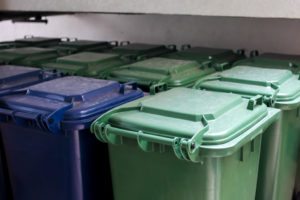 “It’s been a resounding success,” said Robert Costanzo, engineering and operations manager for Surrey, British Columbia.
“It’s been a resounding success,” said Robert Costanzo, engineering and operations manager for Surrey, British Columbia.
Detailing the development and the rollout of extended producer responsibility (EPR) systems in three Canadian provinces, webinar speakers made the case that the EPR approach has led to higher diversion rates and increased access to recycling services.
In EPR systems, brand owners are mandated to fund and/or manage recovery systems for the products they put in on the market in a given jurisdiction.
The recent webinar was hosted by the Product Stewardship Institute, a nonprofit group that advocates for producer responsibility policies.
Adapting to the new order
Systems currently in place in British Columbia, Ontario and Quebec were discussed during the webinar. British Columbia and Quebec call on producers to fund all program costs, and Ontario, until recently, has required municipalities and producers to split costs.
According to Claudia Marsales, a senior manager in Markham, Ontario, a city with about 300,000 residents, the infusion of producer funding into the province’s extensive curbside recycling system has been critical.
“It really was seamless. It is a funding model to help cover the costs and make the service more efficient,” Marsales said.
She said a wide range of materials are collected in Ontario and the province has attained a 60 percent diversion rate. That’s been made possible by a unique funding structure established by the Waste Diversion Act of 2002 that calls on municipalities and producers to split the costs of the program.
“It was a good model on both sides,” Marsales said.
Nicolas Boiselle, a waste management advisor for the Quebec Ministry of Sustainable Development, told listeners that the province has also achieved a residential diversion rate north of 60 percent. The province has had an EPR law in place since 2005 that is intended to cover all costs of running municipal programs for printed paper and packaging.
“It was somewhat easy to integrate existing services and infrastructure,” Boiselle said.
All three province speakers noted the impact of EPR programs on existing programs and infrastructure was minimal. While the funding structure changed, most communities continued running programs as usual.
Program funding questions
Still, representatives from the provinces also noted some kinks need to be worked out to ensure programs continue to thrive.
Marsales noted Ontario’s current system “is not perfect.” While municipalities and producers have been called on to split the cost of municipal recycling program, that hasn’t always occurred. Brand owners last week were notified they would have to increase funding for the program in 2017.
According to Marsales, municipalities have ended up paying more than their share since the province introduced its hybrid EPR program and under recently passed legislation, brand owners will be expected to pay 100 percent of the costs. “Now it’s really time to move on,” she said of the new legislation.
Costanza from Surrey, who spoke glowingly of working with brand owners in British Columbia, also said municipalities aren’t always reimbursed fully for the costs of running their programs. British Columbia transitioned to a full EPR program for printed paper and packaging in 2014.
He said Surrey, which has a population of over 460,000 residents, receives about $4.5 million a year to run its program. That sum is not quite enough, he noted.
“It didn’t cover 100 percent of our costs, but it did cover most of our costs,” Costanza said.
To help solve similar challenges in Quebec, the government there is exploring a handful of options to improve program funding and performance.
While the program is intended to cover 100 percent of the net costs of municipal programs, Boiselle noted it isn’t. In addition, there are no performance standards under the law in Quebec to ensure diversion rates keep climbing.
Currently, Quebec is evaluating some adjustments to the program, including an approach that would call on producers to take over sorting and processing contracting and oversight.
“We’re talking about a full EPR system, where producers would be responsible for managing the program from A to Z,” Boiselle noted.
He said Quebec is still “evaluating the advantages and disadvantages of these approaches.”

